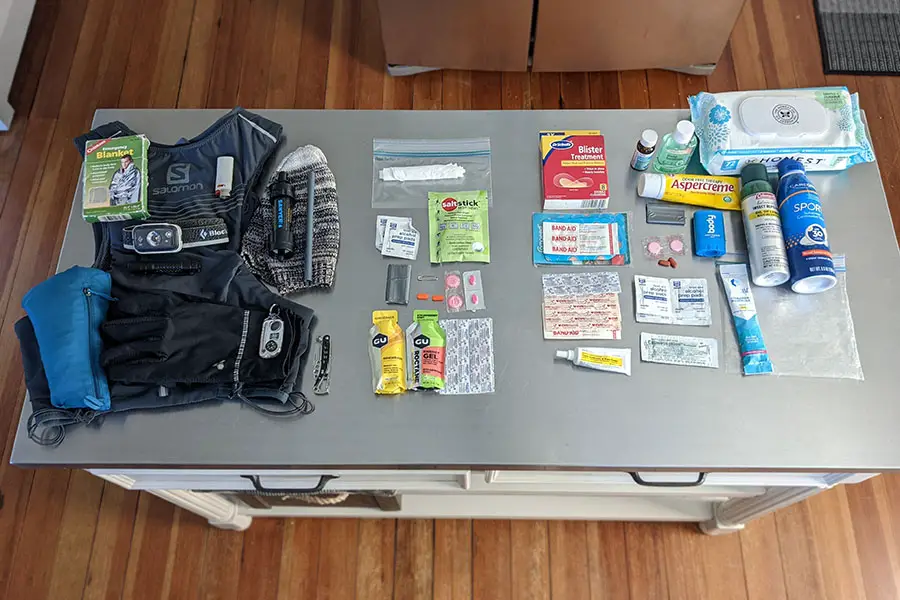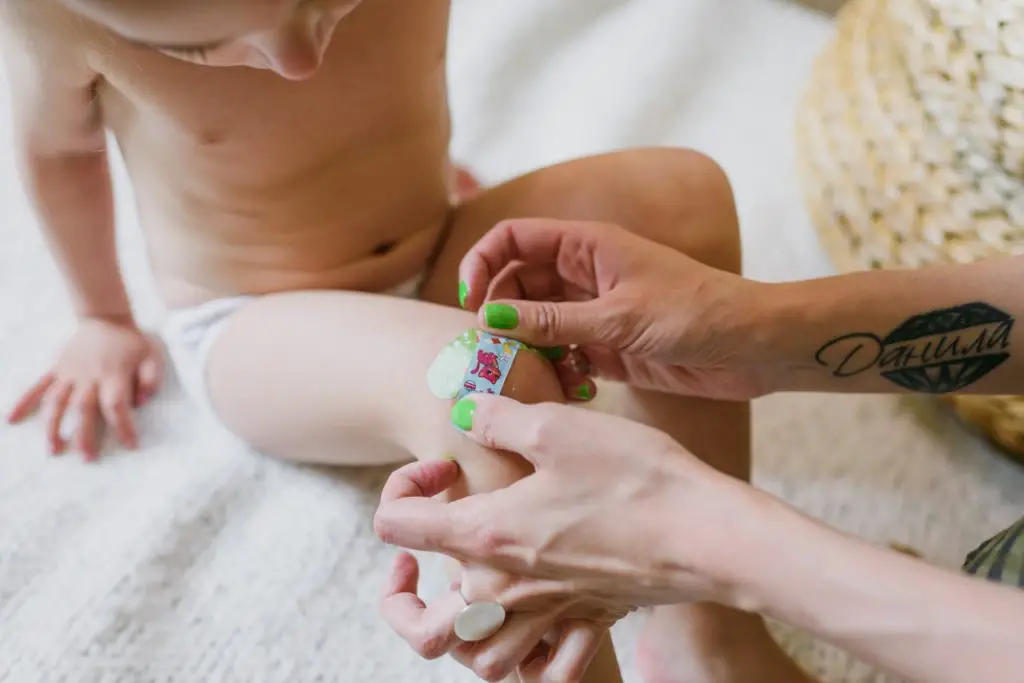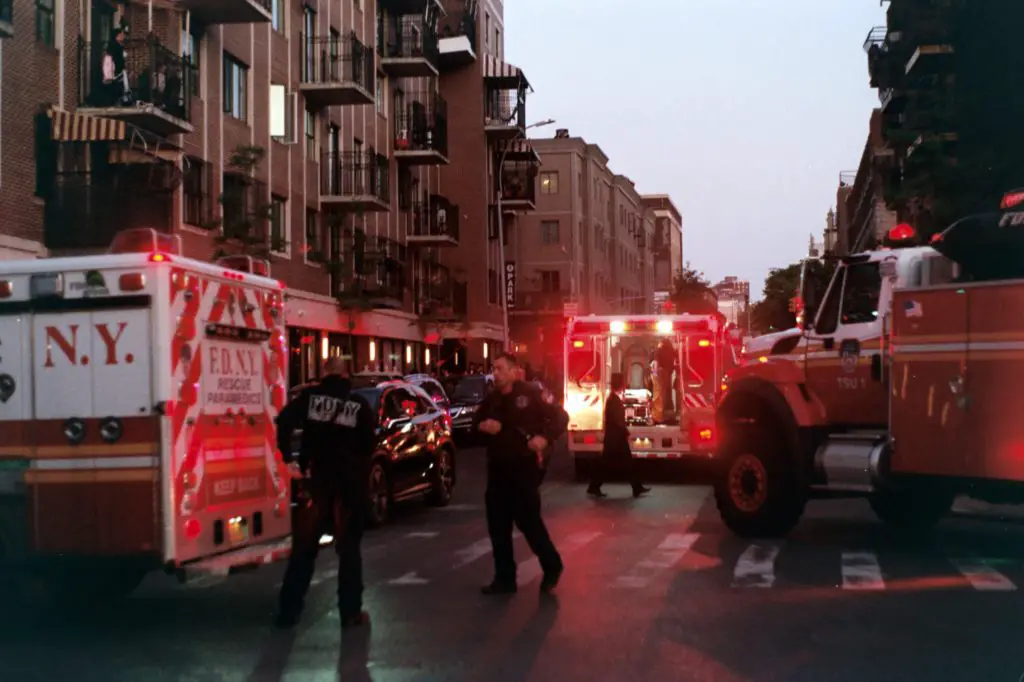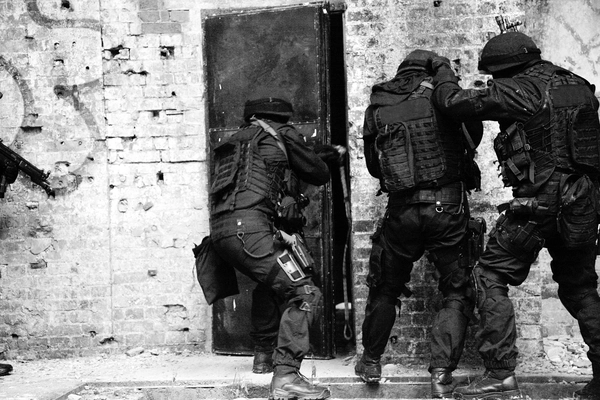Trail running for me grew from a love of backpacking. I love to move through the woods, and being able to run meant I got to travel further in the same amount of time. But the further you go, the more self-sufficient and prepared you need to be for injuries, exposure, or getting lost. Below I outline the items that should be carried in your running first aid kit, how to expand that kit for longer runs, what to keep in the car for afterward, and some general tips to keep yourself safe and healthy.
Running First Aid Kit
This first aid kit is what I keep on me for just about any run in the trails or longer runs on the road. This kit is geared towards minor scrapes, addressing blisters and hot spots, and bathroom emergencies.
- Alcohol Prep Pads – I usually carry four. Use these for sanitizing a needle or cleaning a wound.
- Duct Tape – You can create a mini roll by peeling tape of and rolling it on itself or around a straw.
- Safety Pins – I carry two in case I have to pop a blister.
- Adhesive Bandages – I usually carry four. One for my knuckle, one for my finger, and two 1″x3″ sized ones. Get the kind with the antiseptic coating already applied to the bandage.
- Pepto Bismol – I you run a lot, you are sure to have had stomach issues while running. Keep these on hand for diarrhea, nausea, and upset stomach.
- Ibuprofen – Good for when those downhills are beating you up or for the ride home. If you twist or roll an ankle, you can use these to keep the inflammation down.
- Benadryl – Some people are prone to allergic reactions more than others, but it’s always good to keep a dose on hand. They can also be useful for insect stings.
- Electrolyte Tablets – These are good to take before long runs, but you’ll need to keep your electrolyte levels up while running, so keep some on hand in case.
- Toilet Paper – You’ll be happy to have it if nature calls.
- Snake Bite Kit – This isn’t something I personally carry, but the idea of poison snakes terrifies me and I’m glad to live somewhere without them!
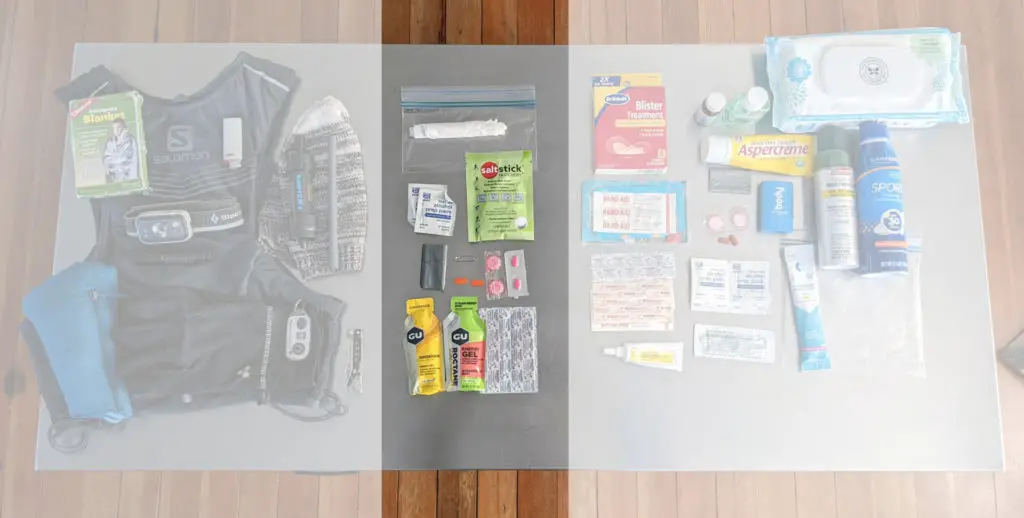
Visit this article for a full guide on How To Create A Blister Kit
Emergency and First Aid Items To Carry On Extended or Unsupported Runs
When I’m going on longer runs, especially as I travel further from help, I’ll start to add in the items below based on the conditions and the environment. The goal is to add items that will get you back to the car or safety as quickly as possible or to remain safe while waiting for help to arrive.
- Extra Calories – You’ll want to bring some form of calories beyond what you’ve calculated you’ll need for your run. If you get off track and extend the run longer than planned, having extra calories will help you get back much easier. I prefer gels for this because they are small and lightweight.
- Electrolytes – If you’re planning a longer run, having electrolytes in your water can help you maintain levels and not enter a deficit. You should also carry a couple of extra pills or something like Liquid I.V. to add to water if you plan on refilling your water mid-run.
- Headlamp – This is a hard topic to cover in a few sentences, but generally you’ll want a minimum of 30 lumens to walk safely in the woods. You can get a super light-weight headlamp or flashlight to get you up to 100 lumens. If you want to be able to run home, I would suggest a minimum of 150 lumens, or 300 lumens to run comfortably.
- Water Filtration – This is essential when running in remote areas. At a minimum, a couple of iodine tablets for an emergency, but these take time (30 minutes+) to work. A life straw is small, but wont allow you to fill up a container. I suggest a Sawyer Mini. It’s small, lightweight, can be used like a straw, but can also fill up your containers.
- Fire Starter – Keep a lighter in a waterproof container, or carry some waterproof matches.
- Compass Keychain – It’s not the best compass, but it can generally get you going in the right direction if you’re disoriented.
- Whistle – If you’re lost, this can be used to signal to rescuers. Some running vests have these built it.
- Windbreaker – Having a layer to put on while you stop when your sweaty is critical for maintaining body temperature. You may want something heavier depending on the conditions. Get something light and packable.
- Emergency Blanket – Mylar blankets are great for reflecting heat back to your body and stopping wind.
- Poncho – A cheap one from the dollar store is all you need. Even if it’s well above freezing, the chance of getting hypothermia in the rain skyrockets. It’s also great for blocking the wind.
- SPOT or other GPS device – If you’re in a remote area, having a small SOS beacon is the best way to get rescuers to you fast.
- Map – A paper map is essential for any remote areas in case your phone battery dies or phone service is lost.
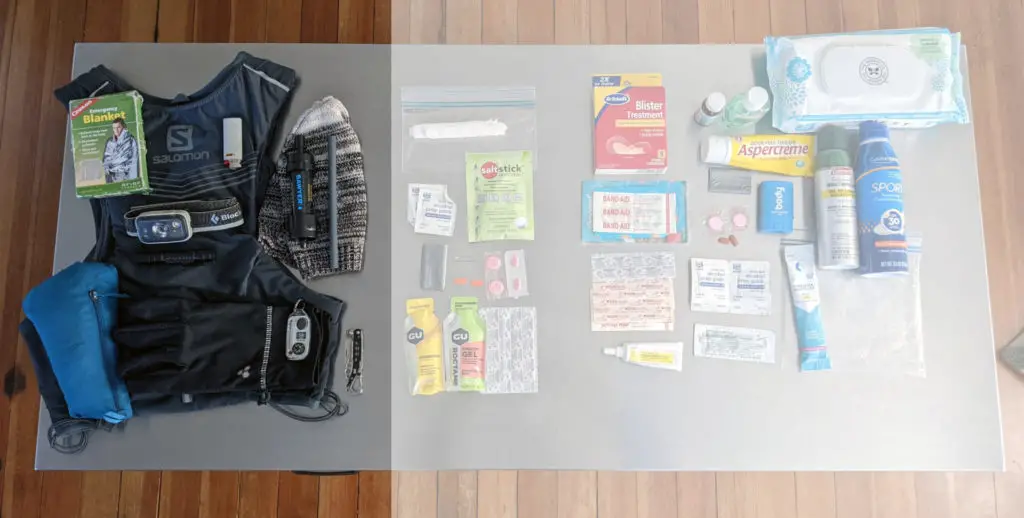
Running First Aid Items To Keep In The Car Or At Transition
These are the items I keep in the car for some aftercare before I get home. When you have a long drive after a hard effort, you’ll want some amount of comfort. Plus, addressing anything that might get infected or removing the oils from poison ivy is time-sensitive. I use this same list when I’m packing a first aid kit for a transition box during long races, that way I can address issues mid-race.
- Cleaning / Sanitation Products – At least have more alcohol pads on hand. I suggest including a small bottle of hydrogen peroxide.
- Hand Sanitizer – Clean your hands, use on cuts if needed, or use to sanitize a needle.
- Nitrile Gloves – In case you need to help someone else or your hands are excessively dirty.
- Irrigation Syringe – When you take a fall on the trail, these are great for cleaning the dirt, rocks, and debris out of your road rash. You can use water or a saline solution to irrigate the wounds.
- Antibiotic Ointment with Pain Relief – I apply this to a bandage before covering up a wound.
- Additional Adhesive Bandages – Cover up all those scratches and scrapes before you head home.
- Liquid Bandage – This might be better for transition area kits because you can quickly apply it and you don’t have to worry about it coming off while you continue your run.
- Blister Bandages – These are bandages specific for blisters. They are usually water proof, have a smooth surface to allow your shoes to slip over them easily, and are padded. In my experience, they are pretty useless running, but are great for afterwards. Compeed, Band-Aid Brand, and Dr Schols all make them.
- Body Glide – This is like a mini deodorant stick that lubricates areas of your body that are prone to chafing. I always apply this on my feet before a long run where I know I get hot spots, and sometimes reapply during if needed.
- Calmoseptine Ointment – This is a moisture barrier that helps protect, soothe, and promote healing on skin irritations from urine, diarrhea, sweat, or chaffing. You can use this before a run as a lube in areas you aren’t going to want to use your body glide. It’s also good to use for relief afterwards.
- Aspercreme – This is an odor free cream that actually relieves pain rather than masks it like Bengay or Icyhot. I find it works well before, during and after, but it does leave your hands greasy.
- Bug Spray – Sometimes you get to a trail head and get swarmed by bugs when there weren’t any at home. I always keep a dedicated can in the car.
- Tweezers / Tick Remover
- Elastic Bandage (ACE Bandage) – These are stretchable bandages that come in a roll that can either be self-adhering or be secured with clips. They are most often used to compress and support joints like the knees, ankles, or a wrist, especially in the case of sprains.
- Extra Water / Electrolytes / Calories – In general, bringing more water and food then you need is a good idea. I usually have a protein shake ready for the car ride home.
- More Duct Tape – I’ll often just keep a whole roll in the car.
- Wet Wipes / Poison Ivy Wipes – These are great for bathroom breaks or a quick wipe down afterwards. Poison ivy wipes are designed to remove the oils from poison ivy to help minimize any effects on your skin.
- Multi-Tool – Having a knife on hand is always a good idea. Pliers can always come in handy. You may want to use the file for sharp or broken nails.
- Nail Clippers – Not a bad idea to keep a pair handy, especially when you forget to trim your nails beforehand.

How To Prevent Blisters and Chaffing While Running
Prevention is always better than a fix mid-run or dealing with the effects afterward. Once you’ve been running for a while, you’ll know where hot spots occur, on what terrain, and in what shoes. The best thing you can do is test your gear out to make sure it fits well before longer runs or on race day.
- Get the Right Shoes – This is obvious, but if you’re getting hot spots on every run over an hour, you may have the wrong shoes. I’d suggest going to a running store that can get you fitted properly. Often times just changing your insoles is enough.
- Get the Right Socks – It’s worth investing in a good pair of running socks, especially for your long runs. Smart Wool, Darn Tough, and Balega socks are all good options. You’ll want them tight fitting so that you foot doesn’t move in the sock, that way rubbing occurs between the sock and shoe, not your foot.
- Get the right Underwear – I like a tight fitting, sports specific, moisture wicking pair. Longer legs will protect your thighs from rubbing together. Look for seams on the inside – if you can feel them, they will rub and create chaffing over time.
- Gaiters – If you’re prone to getting debris in your shoes, invest in some gaiters. The debris can lead to sores and blisters, and you wont want to be stopping regularly during a race to empty your shoes. Shoe brands like Altra are built to accept gaiters, but generic gaiters can work with almost all shoes.
- Lube Up – Use a sports specific lubricant to allow whatever is rubbing to slide easily without friction. Common areas are between toes, outside edge of feet or arch, and thighs.
- Apply Blister Tapes – If you always get blisters in the same spot, you may need to apply a protective tape pre-emptively.
An ouce of prevention is worth a pound of cure.
Benjamin Franklin
Visit this article for a full guide on How To Create A Blister Kit
Preventing Other Common Running Problems or Injuries
- Protect Your Legs – Not only do calf sleeves promote circulation, but they are great for protecting your legs. They can help keep ticks away, protect against poison ivy/oak, thorns and briars, etc.
- Getting Lost – It’s not uncommon to get turned around on new terrain, but getting lost is preventable. Spend some time getting to know the route beforehand by studying maps. Read reviews if they are available so you know what to expect. Bring your phone, a paper map, and a GPS emergency beacon if needed.
- Know Water Sources – If you are relying on natural water sources for refills, make sure you can carry the amount of water needed between sources. Also know that smaller streams or springs can dry up in late summer or during droughts. Try to plan for passing more water sources than you’ll actually need in case some of the sources are dried up.
- Sunburns – If you are exposed to the sun, then protect your skin. Wear a hat, long sleeves, and put on sunblock.
- Bug Bites – If it’s black fly season, or the horse flies are out, they can make your runs miserable. Put on some bug spray beforehand and cover up skin where you can.
Running Vests, Waist Packs, and Handheld Bottles
How you carry your water and gear is a personal choice. I’ve bought several versions of each and I would never know what I’d like without testing them out first. For medium runs, I find the handheld bottles to be sufficient. The small pockets can hold a first aid kit and a few gels. Many of them don’t hold a phone, however, so be sure you research them first. I usually use an armband for my phone anyways. For longer runs, I prefer a running vest. I’ve run with a cheap one (<$40) which held up for a few years and worked well with bladders. Those tend to be heavier, less breathable, and don’t hold flexible bottles in the front very well. Once I bought a Salomon Advanced Skin 5, I won’t go back. As for your first aid kit, anything more than a ziplock bag is unnecessary. Ziplock bags have kept my kits dry during swims in a Spartan Ultra race and during water crossings. They are also the most lightweight options.
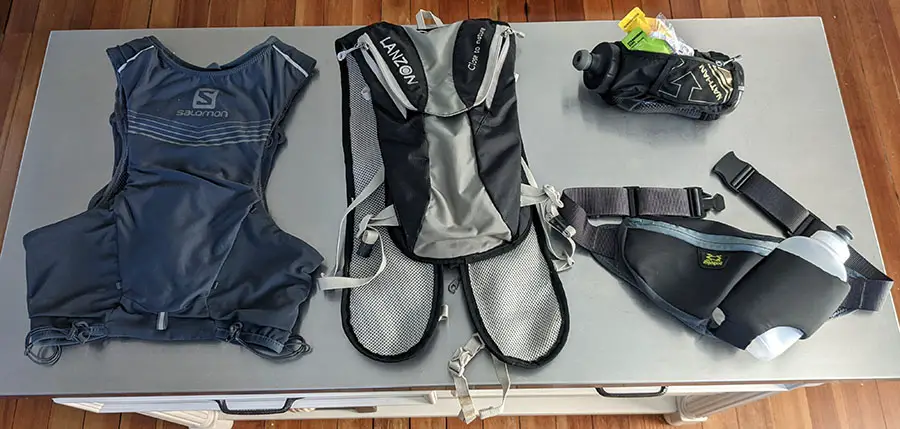
What kind of medical kits do you carry on you while running? Anything missing from my kits? Any recommended products? Leave a comment below.

